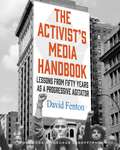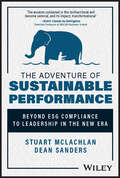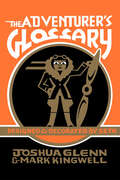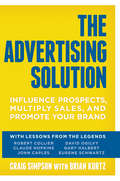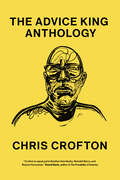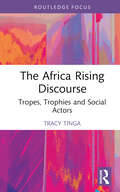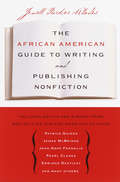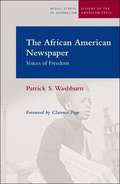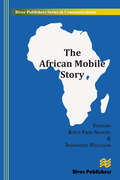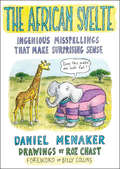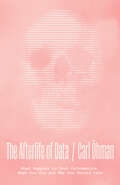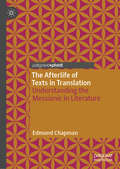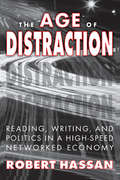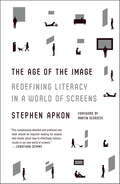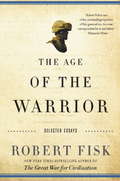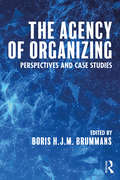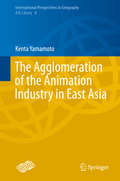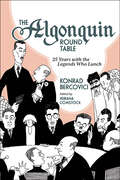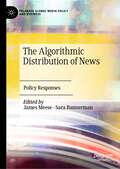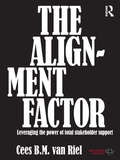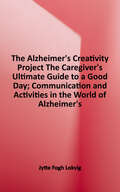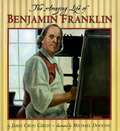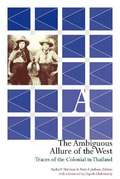- Table View
- List View
The Activist's Media Handbook
by David FentonA Simon & Schuster eBook. Simon & Schuster has a great book for every reader.
The Advanced Reading-Writing Connection
by John LanganThe Advanced Reading-Writing Connection will help you become a more effective reader and writer. You will learn, in a nutshell, that good readers (1) recognize a main point and (2) recognize the support for that point, and that good writers (1) make a point and (2) support the point.
The Advancing World of Applied Electromagnetics: In Honor and Appreciation of Magdy Fahmy Iskander
by Akhlesh Lakhtakia Cynthia M. Furse Tom G. MackayThis book commemorates five decades of research by Professor Magdy F. Iskander (Life Fellow IEEE) on materials and devices for the radiation, propagation, scattering, and applications of electromagnetic waves, chiefly in the MHz-THz frequency range as well on electromagnetics education. This synopsis of electromagnetics, stemming from the life and times of just one person, is meant to inspire junior researchers and reinvigorate mid-level researchers in the electromagnetics community. The authors of this book are internationally known researchers, including 12 IEEE fellows, who highlight interesting research and new directions in theoretical, experimental, and applied electromagnetics.Provides a single-source reference to many of the most significant developments of the past 5 decades in theoretical, experimental, and applied electromagnetics;Offers readers in each sub-discipline discussed current research trends, the state of the art, the chief toolsneeded in that area, and the vision of a research leader for that area;Includes content of particular interest in Antennas and Propagation, as well as Microwave Theory and Techniques.
The Adventure of Sustainable Performance: Beyond ESG Compliance to Leadership in the New Era
by Dean Sanders Stuart McLachlanA guidebook for leaders to create value from sustainability and organisational performance. The Adventure of Sustainable Performance seeks out bold pioneers or forgotten pioneers who need reinvigorating and to be inspired with renewed purpose. Leaders who want more than just modest incremental efficiency gains, who want to create value, to deliver positive impact and meaningful change, should welcome this book. In a time of disruption like never before, boundaries will need revisiting, systems need reimagining, and assets need repurposing through wise stewardship. The authors share their many years of experience serving clients and driving performance as the world transitions to a net zero carbon future. A future that uses resources sustainably and that seeks social justice. Through storytelling and interviews from many international leaders in business and sustainability, and by anchoring practical advice with evidence and truth, you will find: The avalanche of new regulations and changes to the compliance landscape The opportunity for value creation beyond compliance box ticking Inspirational stories on how ambitions can be reset A destination that supports ongoing prosperity for humanity from sustainable performance models How purpose driven brands generate superior value The role of ‘Total Value Systems’ as we move from shareholder to stakeholder capitalism models. The relationship between sustainability, talent and customer attraction How digital will play an increasingly important role as the world pivots in response to the climate crisis Be in no doubt, The Adventure of Sustainable Performance describes an adventurous journey, uncomfortable at times, where a new and cold reality is dawning. But, in a period when the world will continue to play at denial or talk more of ruins, this book helps leaders to instead see foundations. Foundations upon which the new era will be built, and new systems of value will be realised. Perfect for executives, managers, directors, and other business leaders, The Adventure of Sustainable Performance is an actionable guidebook for the implementation of value-add sustainability programmes.
The Adventurer's Glossary
by Joshua Glenn Mark KingwellAdventure is always escapist and often utopian, yet we find solidarity with others and Kafkaesque existential rabbit holes within the words we use to celebrate high-flying escapades. Even when adventures are small in the cosmic scope, the terminology of thrilling exploits promotes a life lived at a high pitch. This go-to glossary for the philosophical explorer delves into these contradictions and insights through more than five hundred terms, from A-OK to zoom. Semiotician Joshua Glenn sourced terms from Shakespeare, military and biker jargon, hip hop and surfer slang, survivalist and gamer subcultures, comic books, extreme sports, and beyond to ask questions about meaning and selfhood. This diverting survey, paired with copious illustrations by the acclaimed cartoonist Seth, is introduced by Mark Kingwell in a thought-provoking essay.The Adventurer’s Glossary extends the entertaining and incisive critique found in the trio’s previous books, The Idler’s Glossary and The Wage Slave’s Glossary. This third instalment turns its lens to the language of risk, excitement, and journeying into the unknown, taking readers on their own semantic adventure.
The Advertising Solution: Influence Prospects, Multiply Sales, and Promote Your Brand
by Craig Simpson Brian KurtzDistilling the wisdom of the world's greatest advertisers, direct marketing expert Craig Simpson delivers an education on direct marketing and advertising copy that creates brand awareness, sells products, and keeps customers engaged. Walks readers through time-tested methods of creating effective ad copy that increases profits. Dissects the principles of legendary marketers like Robert Collier, Claude Hopkins, John Caples, and David Ogilvy.
The Advice King Anthology: The Advice King Anthology
by Chris CroftonSince the fall of 2014, The Advice King has been one of the most widely read sections of alt-weekly the Nashville Scene. The Advice King Anthology contains the best of those columns, with new In-the-Meantime notes, a new introduction, and a foreword by writer Tracy Moore. If you are looking for traditional advice, this might not be the book for you. But if you care to find the incendiary, subversive, and hilarious alongside actual thoughts about addiction, depression, gentrification, politics, poetry, music, economic policy, living in New Nashville, and (inevitably) romance, the Advice King has much to offer.
The Africa Rising Discourse: Tropes, Trophies and Social Actors (Routledge Contemporary Africa)
by Tracy TingaOver the last 25 years, the "Africa Rising" discourse has been used to signify hope and promise for the continent, marking a break from previous pessimistic portrayals. This book critically examines that discourse, analyzing recurring themes, tropes, metaphors, and imagery.It traces the evolution of the "Africa Rising" discourse and its connection with Afro-pessimism, providing valuable insights into how the continent is represented and understood. The book explores the tensions, contradictions and impacts of labeling Africa as "rising". Focusing on both local and global social actors, as well as geopolitical influences, it examines how these forces have shaped the discourse over time. Additionally, it highlights how African actors have engaged with and modified the discourse. For instance, the book assesses how in recent years digital media platforms have offered spaces for counternarratives that challenge stereotypical representations, leading to a more nuanced and diverse understanding of Africa’s rise.This book offers valuable insights for researchers in Media and Communication Studies, Digital Media, Journalism, African Studies, and Global Studies.
The African American Guide to Writing & Publishing Non Fiction
by Jewell Parker RhodesIn college and graduate school, Jewell Parker Rhodes never encountered a single reading assignment or exercise that featured a person of color. Now she has made it her mission to rectify the situation, gathering advice and inspiring tips tailored for African Americans seeking to express their life experiences. Comprehensive and totally energizing, the African American Guide to Writing and Publishing Nonfiction bursts with supportive topics such as: ·Finding your voice·Getting to know your literary ancestors·Overcoming a bruised ego and finding the determination to pursue your dreams·Gathering material and conducting research·Tapping sweet, bittersweet, and joyful memories·Knowing when to keep revising, and when to let goThe guide also features unforgettable excerpts from luminaries such as Maya Angelou, Brent Staples, Houston Baker, and pointers from bestselling African American authors Patrice Gaines, E. Lynn Harris, James McBride, John Hope Franklin, Pearl Cleage, Edwidge Danticat, and many others. It is a uniquely nurturing and informative touchstone for affirming, bearing witness, leaving a legacy, and celebrating the remarkable journey of the self.
The African American Newspaper: Voice of Freedom (Visions of the American Press)
by Patrick WashburnIn March of 1827 the nation's first black newspaper appeared in New York City--to counter attacks on blacks by the city's other papers. From this signal event, The African American Newspaper traces the evolution of the black newspaper--and its ultimate decline--for more than 160 years until the end of the twentieth century. <p><p> The book chronicles the growth of the black press into a powerful and effective national voice for African Americans during the period from 1910 to 1950--a period that proved critical to the formation and gathering strength of the civil rights movement that emerged so forcefully in the following decades. In particular, author Patrick S. Washburn explores how the Pittsburgh Courier and the Chicago Defender led the way as the two most influential black newspapers in U.S. history, effectively setting the stage for the civil rights movement's successes. Washburn also examines the numerous reasons for the enormous decline of black newspapers in influence and circulation in the decades immediately following World War II. His book documents as never before how the press's singular accomplishments provide a unique record of all areas of black history and a significant and shaping affect on the black experience in America.
The African Mobile Story (River Publishers Series In Communications Ser.)
by Idongesit Williams Knud Erik SkoubyAfrica and especially Sub-Saharan Africa has during the past decade witnessed one of the fastest growing markets in mobile communication. This growth is recognized to have played a pivotal role in Africa’s socio-economic development. It has had a huge impact on residential living patterns; on business networks and models; and on government services and income sources. The mobile industry has contributed more to economic growth than in any other comparable region globally introducing innovative, broadly used applications. Technical topics discussed in the book include:• Mobile Development in Sub-Saharan Africa;• Telecom Liberalization in Africa;• Role of Mobile in Socio-economic Development;• Mobile Applications in specific sectors;• Security in African Mobile;• Role of Prepaid in Africa
The African Svelte: Ingenious Misspellings That Make Surprising Sense
by Daniel Menaker&“For language lovers, this book, with all its verbal tangles and wit, is sure to, in its own words, &‘pass mustard&’&” (Poets & Writers). Inspired by Daniel Menaker&’s tenure at the New Yorker, this collection of comical, revelatory errors foraged from the wilds of everyday English comes with commentary by the author, illustrations by Roz Chast, and a foreword from Billy Collins. During his time at the renowned magazine, Menaker happened across a superb spelling mistake: &“The zebras were grazing on the African svelte.&” Fascinated by the idea of unintentionally meaningful spelling errors, he began to see that these gaffes—neither typos nor auto-corrects—are sometimes more interesting than their straight-laced counterparts. Through examples he has collected over the course of his decades-long career as an editor and writer, he brings us to a new understanding of language—how it&’s used, what it means, and what fun it can be. Illustrated by the inimitable Roz Chast, with a foreword by former poet laureate Billy Collins, The African Svelte offers thoughtful and intelligent exit Jesus. With both uniquely happy accidents and familiar fumbles like &“for all intensive purposes&” and &“doggy-dog world,&” readers delighted by language will find themselves turning the pages with baited breath to discover fresh howlers that have them laughing off their dairy airs.
The Afterlife of Data: What Happens to Your Information When You Die and Why You Should Care
by Carl ÖhmanA short, thought-provoking book about what happens to our online identities after we die. These days, so much of our lives takes place online—but what about our afterlives? Thanks to the digital trails that we leave behind, our identities can now be reconstructed after our death. In fact, AI technology is already enabling us to “interact” with the departed. Sooner than we think, the dead will outnumber the living on Facebook. In this thought-provoking book, Carl Öhman explores the increasingly urgent question of what we should do with all this data and whether our digital afterlives are really our own—and if not, who should have the right to decide what happens to our data. The stakes could hardly be higher. In the next thirty years alone, about two billion people will die. Those of us who remain will inherit the digital remains of an entire generation of humanity—the first digital citizens. Whoever ends up controlling these archives will also effectively control future access to our collective digital past, and this power will have vast political consequences. The fate of our digital remains should be of concern to everyone—past, present, and future. Rising to these challenges, Öhman explains, will require a collective reshaping of our economic and technical systems to reflect more than just the monetary value of digital remains. As we stand before a period of deep civilizational change, The Afterlife of Data will be an essential guide to understanding why and how we as a human race must gain control of our collective digital past—before it is too late.
The Afterlife of Texts in Translation: Understanding the Messianic in Literature
by Edmund ChapmanThe Afterlife of Texts in Translation: Understanding the Messianic in Literature reads Walter Benjamin’s and Jacques Derrida’s writings on translation as suggesting that texts exist within a process of continual translation. Understanding Benjamin’s and Derrida’s concept of ‘afterlife’ as ‘overliving’, this book proposes that reading Benjamin’s and Derrida’s writings on translation in terms of their wider thought on language and history suggests that textuality itself possesses a ‘messianic’ quality. Developing this idea in relation to the many rewritings and translations of Don Quijote, particularly the multiple rewritings by Jorge Luis Borges, Edmund Chapman asserts that texts consist of a structure of potential for endless translation that continually promises the overcoming of language, history and textuality itself.
The Age of Distraction: Reading, Writing, and Politics in a High-Speed Networked Economy
by Robert HassanConnections between time, technology, and the processes of reading and writing make clear the links between experiences of what appear to be quite different phenomena. Reading and writing have functioned together in a particular way to build the world as we have known it for three thousand years. These interacting processes have now been transformed at their core and are building a different world, one where certainties of the previous era are disappearing and being displaced by what the author sees as a chronic and pervasive mode of cognitive distraction. Robert Hassan offers a perspective permeated by a sense of history, beginning with the invention of writing and the development of the skill of reading. Together with technological developments, these provide a unique view of the trajectory of modernity into late-modernity, and illustrate how the arc of progress has transformed. New modes of time, technology, and reading and writing are helping create a faster world where we know less about more-and forget what we know evermore quickly. What is the "time" of a thought? Is it possible to measure thinking? Can we consider knowledge or information, or reading and writing, as having temporal "rhythms"? These are questions Hassan tries to answer. So unfamiliar are we to thinking in such terms that they sound impossible. To a significant degree, time, thinking, and many forms of knowledge are the fruits of subjective experience. We connect experiences at superficial levels, where people have different experiences that may be objectively the same, but our interpretations will always diverge in respect of the "reality" we confront. This intersection of philosophy and communication takes the reader into new realms of analysis.
The Age of the Image: Redefining Literacy in a World of Screens
by Stephen ApkonAn urgent, erudite, and practical book that redefines literacy to embrace how we think and communicate nowWe live in a world that is awash in visual storytelling. The recent technological revolutions in video recording, editing, and distribution are more akin to the development of movable type than any other such revolution in the last five hundred years. And yet we are not popularly cognizant of or conversant with visual storytelling's grammar, the coded messages of its style, and the practical components of its production. We are largely, in a word, illiterate. But this is not a gloomy diagnosis of the collapse of civilization; rather, it is a celebration of the progress we've made and an exhortation and a plan to seize the potential we're poised to enjoy. The rules that define effective visual storytelling—much like the rules that define written language—do in fact exist, and Stephen Apkon has long experience in deploying them, teaching them, and witnessing their power in the classroom and beyond. In The Age of the Image, drawing on the history of literacy—from scroll to codex, scribes to printing presses, SMS to social media—on the science of how various forms of storytelling work on the human brain, and on the practical value of literacy in real-world situations, Apkon convincingly argues that now is the time to transform the way we teach, create, and communicate so that we can all step forward together into a rich and stimulating future.
The Age of the Warrior: Selected Essays by Robert Fisk
by Robert FiskRobert Fisk has amassed a massive and devoted global readership with his eloquent and far-ranging articles on international politics. Now, for the first time, his brave and incisive essays have been collected in a single volume that ranges in scope from the recent war in Lebanon to the rise of Hamas; from the invasion of Kuwait to the looting of Baghdad; from America's imperial ambitions to the inescapable influence of the Treaty of Versailles. Taken together, these articles form an unparalleled account of our war-torn recent history.
The Agency of Organizing: Perspectives and Case Studies
by Boris H. BrummansWinner of the 2018 Outstanding Edited Book Award from the Organizational Communication Division of the National Communication Association The Agency of Organizing explains why the notion of agency is central to understanding what organizations are, how they come into existence, continue to exist, or fade away, and how they function. Written by leading organizational communication scholars, the chapters in this edited volume present seven different theoretical perspectives on agency in the dynamics of organizing. Authors discuss how they conceptualize agency from their own perspective and how they propose to investigate agency empirically in processes of organizing by using specific methods. Through insightful case studies, they demonstrate the value of these perspectives for organizational research and practice.
The Agglomeration of the Animation Industry in East Asia
by Kenta YamamotoThis book will be of interest to scholars and students of Asian studies, cultural industries, economic geography, and related areas of study. It discusses the results of a microscopic survey focusing on topics such as how animation studios form business relationships and how workers gain skills in the industry. The methodology was based on traditional Japanese economic geographical methods. The study also examines macroscopic issues such as why industrial agglomerations are formed in metropolises, why metropolises develop mutual networks, and how a type of cultural product is created in the metropolises. The methodology uses case studies of the animation industries in Japan, South Korea, and China. The detailed analysis covers the process of the industry's agglomeration within the East Asian metropolises of Tokyo, Seoul, and Shanghai as well as the division of labor among them. In addition, the transaction relationships among animation studios are examined, together with the promotion of the industry in the peripheral region of Okinawa, Japan. Differences in work styles and output among these cities are also examined. The research presented in this book contributes to understanding the spatial structure and reality of creativity in an innovative industry, particularly the East Asian content industry.
The Algonquin Round Table: 25 Years with the Legends Who Lunch (Excelsior Editions)
by Konrad BercoviciLocated in New York's theatre district, the Algonquin Hotel became an artistic hub for the city and a landmark in America's cultural life. It was a meeting place and home away from home for such luminaries as famed wits/authors Alexander Woollcott and Dorothy Parker; Broadway and Hollywood stars, including Tallulah Bankhead and Charles Laughton; popular raconteurs like Robert Benchley; and New York City mayors Jimmy Walker and Fiorello LaGuardia. Observing it all was celebrated author and journalist Konrad Bercovici. Born in Romania, Bercovici settled in New York, where he became known for reporting on its rich cultural life. While digging through an inherited trunk of family papers, his granddaughter, Mirana Comstock, discovered this previously unpublished manuscript on Bercovici's years at the Algonquin Round Table. Lovers of New York lore and fans of American culture will enjoy his vivid, intimate accounts of what it was like to be a member of this distinguished circle.
The Algorithmic Distribution of News: Policy Responses (Palgrave Global Media Policy and Business)
by Sara Bannerman James MeeseThis volume explores how governments, policymakers and newsrooms have responded to the algorithmic distribution of the news. Contributors analyse the ongoing battle between platforms and publishers, evaluate recent attempts to manage these tensions through policy reform and consider whether algorithms can be regulated to promote media diversity and stop misinformation and hate speech. Chapter authors also interview journalists and find out how their work is changing due to the growing importance of algorithmic systems. Drawing together an international group of scholars, the book takes a truly global perspective offering case studies from Switzerland, Germany, Kenya, New Zealand, Canada, Australia, and China. The collection also provides a series of critical analyses of recent policy developments in the European Union and Australia, which aim to provide a more secure revenue base for news media organisations. A valuable resource for journalism and policy scholars and students, Governing the Algorithmic Distribution of News is an important guide for anyone hoping to understand the central regulatory issues surrounding the online distribution of news.
The Alignment Factor: Leveraging the Power of Total Stakeholder Support
by Cees B.M. Van RielThe importance of creating a favourable impression is hard to overstate in all walks of life - in business it's vital to achieve strategic goals. Customers, journalists, bloggers, investors, governments and other groups are all important stakeholders in an organizations performance and in persuasively communicating a company's ethical and socially responsible behaviour, these groups can be kept onside. Supported throughout by lively examples, this book contains guidance for implementing strategies that engage stakeholders - highlighting those organizations which employ communication professionals as key performers. Van Riel reveals how a dominant logic develops among executives, which influences styles and techniques of trust-building communication. The practical insights demonstrated via cases including Google, Unilever and Barclays make this book useful reading for MBA and other graduate classes across areas such as public relations and reputation management as well as thinking managers across the globe.
The Alzheimer's Creativity Project: The Caregiver's Ultimate Guide to a Good Day; Communication and Activities in the World of Alzheimer's
by Jytte Fogh LokvigCreative activities for people with Alzheimer's and other dementias in an easy-to-follow format for professionals and family caregivers. A full-color guide to projects, art making, and other purposeful activities, as well as the basics of effective communication and approaches. This book is based on ten years of creativity sessions with people with advanced dementia and late stage Alzheimer's. Creativity is used not simply in the popular terms of the creative arts, but rather in its broadest sense of how we approach everything we do throughout the day. Creativity means letting go of our old notions of doing something, being open to new experiences and allowing ourselves to be open to think out of the box and go with the flow and ebb of our situation and the people we work with. When we discard our standard activity programs and give people the space and time to follow their own schedules, we may witness amazing results, as you'll see in this book.
The Amazing Life of Benjamin Franklin
by James Cross GiblinA biography of the eighteenth-century printer, inventor, and statesman who played an influential role in the early history of the United States.
The Ambiguous Allure of the West
by Rachel HarrisonThe book brings studies of modern Thai history and culture into dialogue with debates in comparative intellectual history, Asian cultural studies, and postcolonial studies. It takes Thai Studies in new directions through case studies of the cultural hybridity and ambivalences that have emerged from the manifold interactions between Siam/Thailand and the West from 1850 to the present day. Central aims of The Ambiguous Allure of the West are to critique notions of Thai "uniqueness" or "exceptionalism" and locate Thai Studies in a broader, comparative perspective by arguing that modern Siam/Thailand needs to be understood as a semicolonial society. In contrast to conservative nationalist and royalist accounts of Thai history and culture, which resist comparing the country to its once-colonized Asian neighbours, this book's contributors highlight the value of postcolonial analysis in understanding the complexly ambiguous, interstitial, liminal and hybrid character of Thai/Western cultural interrelationships. At the same time, by pointing to the distinctive position of semicolonial societies in the Western-dominated world order, the chapters in this book make significant contributions to developing the critical theoretical perspectives of international cultural studies. The contributors demonstrate how the disciplines of history, anthropology, political science, film and cultural studies all enhance these contestations in intersecting ways, and across different historical moments. Each of the chapters raises manifold themes and questions regarding the nature of intercultural exchange, interrogated through theoretically critical lenses. This book directs its discussions at those studying not only in the fields of Thai and Southeast Asian studies but also in colonial and postcolonial studies, Asian cultural studies, film studies and comparative critical theory.
